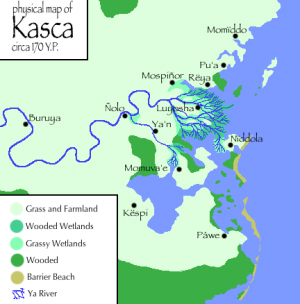Buruya
Buruya is a town on the lower Eigə west of the Delta zone; it is at the western fringe of the area that could be called culturally Kascan. In the early 1st millennium BP it emerged as one of the five major Kascan city-states; several conquests later, it slogged along independently even as central Kasca foundered. In 351 YP it was acquired by the expanding Empire of Huyfárah, but was lost again in the early 6th century, and fell into the hands of the Dāiadak.
The city is the sole major connection point between two economic spheres - Huyfárah and Kasca on the coast, and Lasomo and the Rathedān further inland - which has helped Buruya become one of the most important trade hubs in northeastern Peilaš.
Language
- Main article: Buruya Nzaysa
Until it was replaced by Fáralo, Buruya spoke an Edastean dialect classified, by convention, as a divergent western dialect of Naidda.
Names
| Language | Name | Pronunciation | Source |
|---|---|---|---|
| Buruya Nzaysa | Buruya | [ˈbu.ru.ja] | ← Me. buru "stronghold" + -ya (honorific) |
| Naidda | Buruya | ['bu.ru.jə] | ← B.Nz. Buruya (borrowed) |
| Fáralo | Buruya | [ˈbu.ɾu.ja] | ← B.Nz. Buruya (borrowed) |
| Ndok Aisô | Buxói | [buˈʔɔːj] | ← B.Nz. Buruya (borrowed) |
| Adāta | Buruia, Buroi | [ˈbu.ru.ja], [ˈbu.roɪ] | ← B.Nz. Buruya / N.A. Buxói (borrowed) |
| Æðadĕ | Burujĕ | [ˈbu.ɾu.jə] | ← Vulgar Adāta *Burūia (partially reborrowed) |
| Aθáta | Fúrja | [ˈfuɾ.ja] | ← Ad. Buruia |
| Mavakhalan | Vôrъja | [ˈβo.rja] | ← Ad. Buruia |
| Ayāsthi | Wryï, Ḃuruja | [ˈu.ɹɨ.i], [ˈu.ɹɯ.jɑ] | ← Ad. Buruia |
| Wippwo | Burša | ['bur.ʃa] | ← Ndd. Buruya |
Calendar
Under the influence of Huyfárah, Buruya adopted the kəsusa xara ("Faraghin calendar"), which divided the year (lɛ) into eight full months (xawə́be) of 48 days (əsu), each consisting of six eight-day weeks (yɔti). Most days and months still retained their inherited names; the Etúgə-influenced name for day 3 was borrowed from Fáralo, with the characteristic suffix -yo added.
| Day | Name | Meaning | Comments |
|---|---|---|---|
| 1 | palmayo | the secret one | |
| 2 | atsɔyo | the old wise one | |
| 3 | ɛkuyo | blessing | < F. ekúi |
| 4 | əbeyo | moon | |
| 5 | buliyo | earth | |
| 6 | omɔyo | the mother goddess | |
| 7 | toyo | sun | day of rest |
| 8 | tsuyo | the cold one |
However, the original Ndak Calendar with eight and a half months of 45 days per year and the characteristic alternating 7- and 8-day weeks was not abandoned completely: Since the Ndok – important trade partners of the Buruyans – still used this system as their primary calendar, the kəsusa nzok was required knowledge for any Buruya merchant, all the more so because the different week lengths (gɔyto mvɔ "small Ndok week" and gɔyto tətsɔ "big Ndok week") meant that the days of the week in one calendar constantly shifted relative to those of the other calendar. Most people used the same names for days and months in both calendars, with the mandatory qualifier nzok added when referring to the Ndok system. The original Ndok Aisô terms were preferred among educated speakers though.
